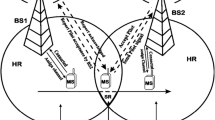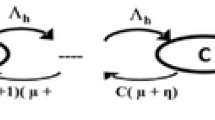Abstract
Handoff will become an increasingly important issue in mobile phone communications, especially in microcellular systems with the increase of handoff traffic between cells. Many approaches have been proposed for handoff analysis. In a previous analysis, it was assumed that the probability density function (pdf) of the speeds of cell-crossing terminals is the same as the pdf of the speeds of all terminals. In contrast to this assumption, we argue that both pdf's are unequal. The pdf of the speeds of cell-crossing terminals is given by a “biased sampling” formula. This boundary condition is used in our study and improves the accuracy of performance measures in handoff analysis. In previous work, a priority handoff system which has dedicated channels for handoff calls and uses a blocked call cleared (BCC) policy has been analyzed. In this paper, we use a different approach in performance analysis. The proposed approach has low computational complexity and high accuracy.
Similar content being viewed by others
References
E. C. Posner and R. Guérin. Traffic policies in cellular radio that minimize blocking of handoff calls.Proceedings of the 11th Teletraffic Cong. (ITC 11), Kyoto, Japan, September 1985, Vol. 1, pp. 2.4B-2-1–2.4B-2-5.
R. Thomas, H. Gilbert, and G. Mazziotto, Influence of the movement of the mobile station on the performance of a radio cellular network,Proceedings of the 3rd Nordic Seminar, Paper 9.4., Copenhagen, September 1988.
D. Hong and S. S. Rappaport, Traffic model and performance analysis for cellular mobile radio telephone systems with prioritized and nonprioritized handoff procedures,IEEE Transactions on Vehicular Technology, Vol. VT-35, No. 3, pp. 77–91, 1986.
R. Guérin, Channel occupancy time distribution in a cellular radio system,IEEE Transactions on Vehicular Technology, Vol. VT-35, pp. 89–99, 1987.
R. Guérin, Queueing-blocking system with two arrival streams and guard channels,IEEE Transactions on Communications, Vol. COM-36, pp. 153–163, 1988.
S. A. El-Dolil, W. C. Wong, and R. Steele, Teletraffic performance of highway microcells with overlay macrocell,IEEE Journal On Selected Areas in Communications, Vol. SAC-7, No. 1, pp. 125–131, 1989.
D. Everitt, Traffic capacity of cellular mobile communications systems,Computer Networks and ISDN Systems, ITC Specialist Seminar, September 25–29, 1989.
S. Tekinay and B. Jabbari, Handover and channel assignment in mobil cellular networks,IEEE Communications Magazine, Vol. 29, No. 11, pp. 42–46, 1991.
T. S. Yum and W. S. Wong, Hot spot traffic relief in cellular systems.Proceedings of ICC'92, Chicago Illinois, pp. 356.3.1–356.3.7, 1992.
M. Schwartz,Telecommunication Networks: Protocols, Modeling and Anlaysis, Addison-Wesley, Reading MA, 1987.
L. Takács,Introduction to the Theory of Queues, Oxford University Press, New York, 1962.
D. R. Cox and P. A. W. Lewis,The Statistical Analysis of Series of Events, Latimer Trend, Whitstable, Great Britain, 1966.
H. Xie and S. Kuek, Priority handoff analysis,Proceedings of VTC'93, Secaucus, NJ, May 18–20, 1993.
H. Xie and D. Goodman, Mobility models and biased sampling problem,Proceedings of the 2nd International Conference on Universal Personal Communications, Ottawa Canada, October 1993.
Author information
Authors and Affiliations
Additional information
The author was a visiting scholar at WINLAB while this work was completed.
Rights and permissions
About this article
Cite this article
Xie, H., Kuek, S. Priority handoff analysis. Int J Wireless Inf Networks 1, 141–148 (1994). https://doi.org/10.1007/BF02106516
Issue Date:
DOI: https://doi.org/10.1007/BF02106516




